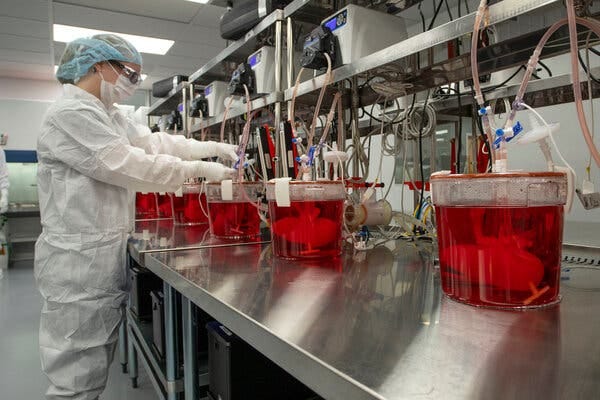

Weekly Dose of Optimism #56
source link: https://www.notboring.co/p/weekly-dose-of-optimism-56
Go to the source link to view the article. You can view the picture content, updated content and better typesetting reading experience. If the link is broken, please click the button below to view the snapshot at that time.

Weekly Dose of Optimism #56
Jobs Biden, Pink Floyd, Pig Kidneys, Humanoids, Coinbase Futures
Hi friends 👋,
Happy Friday and welcome back to our 56th Weekly Dose of Optimism.
Another big week of Optimism over here at Not Boring HQ. We filled all of the slots for this week’s edition by mid-evening on Wednesday, which is about 36 hours ahead of our usual schedule. All that optimism makes our jobs a bit easier and the world a bit better.
Let’s get to it.
The Weekly Dose is brought to you by…Ramp
We are big fans of Ramp, the ultimate platform for finance teams. Such big fans in fact, here’s a short list of the ways we’ve interreacted with them over the years:
Investors: Not Boring Capital has invested in two Ramp rounds
Analysts: Packy has written three deep dives on Ramp
Customers: Most importantly, we use Ramp at both Not Boring and Create. For Create in particularly, Ramp is a very important partner.
You likely already know Ramp has a cash back credit card, but what we really like (and use on a daily basis) is their Bill Pay and Flex products, which extend payment terms on all types of transactions. Its integrations and automations also make closing the books easy each month.
We’re not alone, over 15,000 businesses (of all sizes) use Ramp. If you want to join them and save 3.5% + close your books 8x faster, check them out.
(1) DOE Finds Energy Jobs Have Increased in Nearly Every County in America
From the Department of Energy
Energy employment is increasing in nearly every county across the United States. The number of energy jobs increased in 95% of American counties from 2021 to 2022.
There goes that man again, Jobs Biden.
Seems like all of that investment in clean energy is translating into real jobs growth. The renewable energy sector is benefitting from decades of declining cost curves and pushes towards a clean energy transition, and it seems that the Inflation Reduction Act is accelerating its deployment and job growth in the sector. The IRA has already dumped tens of billions of dollars of investment into spurring the clean energy transition, and that’s translating to real jobs.
Sci-fi ideas are a third of the battle — John Jacob Astor IV wrote about Rooftop Windmills and Windmill Masts in 1894 and Hugo Gernsback imagined solar panels as Helio-Dynamophores in 1911. Turning the ideas into working technology is another third. And actually rolling out the technology is a final third. That part can and continues to create new jobs — over 170,000 new jobs in the last year alone in the case of energy.
(2) Scientists Reconstructed a Pink Floyd Song From Brain Activity
Daniela Hernandez for The Wall Street Journal
Neuroscientists at the University of California, Berkeley reconstructed Pink Floyd’s classic rock song “Another Brick in the Wall, Part 1” using recordings of the brain activity of 29 patients who heard the song while undergoing brain surgery. Though less polished than the band’s version, the reconstructed tune was recognizable.
Last week, we covered that Nueralink (Elon’s Brain Computer Interface company) had raised a $280M Series D to accelerate its products which help patients translate thoughts into physical movements. This week, a team of researchers have gotten one step closer to developing devices that translate brain activity into sound.
Essentially, the device reads brain activity and translates those signals into spoken word or other sounds. You should check out the side-by-side comparison of the song and the brain output in the WSJ article. Such a device would be transformative for people that can’t speak.
But since we’ve been on the Sci-Fi train here recently, let’s take it a step further. Imagine a device that could automatically translate your thoughts into any language, automatically making you a polyglot. Or attaching the device to a baby, translating the brain signals behind nighttime cries into well-articulated statements of need. Or better yet, how about hooking up one of these devices to your pooch…oh if the dogs could talk…
That’s a ways away, but in the meantime, as is the case with most of these cutting edge brain-technologies, people truly in need will be the first to benefit.
(3) Pig Kidneys Performing Effectively in Two Brain-Dead Patients
Roni Caryn Rabin for The New York Times
A number of studies last year demonstrated that pig kidneys that had been transplanted into brain-dead individuals made urine, an essential function, for short periods of time. But the U.A.B. study is the first to clearly show that the organs also filter creatinine, a byproduct of muscle contractions that must be removed from the blood.
Thousands of people die each year waiting for kidney transplants. There’s about a 100,000 person waitlist for kidney transplants in the U.S. each year, but only 25,000 transplants are performed due to a shortage of human organ donors. That’s where the pigs come in!
New research, produced by two separate teams, demonstrates functional pig kidneys in brain-dead human patients. Previous experiments have show that pig-kidneys can make urine, but this new research shows that pig kidneys are also effective at filtering creatinine from the body. (As an aside, creatinine ≠ creatine. Creatinine is the waste product creatine. If your kidneys are functioning properly, taking creatine will not harmfully increase creatinine levels.)
The ability to safely and effectively use animal organs in humans would, of course, limit the shortage organs needed for transplants. We’re still a bit of a ways off: the experiments have only occurred in two brain-dead patients, but the teams are seeking FDA approval for a clinical trial in live patients.
Pigs are becoming humans. Or maybe, humans are becoming pigs. I’m not sure how the logic works there. But whether or not I should eat bacon is about to become a much more morally complex question…
(4) Unitree teases new H1 humanoid robot
Mike Oitzman for The Robot Report
If science keeps progressing, the first step is we all become human pig hybrids. The next step is that we’re replaced by robot humanoids all together.
The race to commercialize humanoid robots is heating up. There’s dozens of companies competing to develop and sell a useful human-like robot, and now, some of the prototypes are quite good. One of those companies, Unitree, introduced its general purpose humanoid robot, called H1, this week. The robot, which walks like a human that needs to find a toilet really badly, is expected to be available for sale in the next “3-10 years” (bit of breathing room there for the team) for under $90,000.
These humanoid robots could perform a range of tasks, from warehouse working to caregiving, to soldiering, and free up time for us pighumans to focus on more worthwhile projects.
From Coinbase
Coinbase will now be the first crypto-native leader to directly offer traditional spot crypto trading alongside regulated and leveraged crypto futures, on an integrated trading solution for our verified customers.
The ability to trade leveraged crypto futures isn’t necessarily cause for optimism in and of itself, but we’re highlighting this story because it’s a big W for Coinbase in its ongoing fight to bring regulatory clarity to the industry.
Coinbase has long held that if the SEC offered a path to register, they’d take it. The registration as a Futures Commission Merchant with the CFTC shows that they’re serious, and the CFTC’s willingness to work with Coinbase highlights a sane approach to regulation.
And as of last night, reports are that the SEC will greenlight Ether-Futures ETFs.
Coinbase has stood strong and it’s starting to get results, for itself and the industry. Props to the company and its CEO Brian Armstrong for fighting the good fight.
Crypto is here to stay. Even if you’re a crypto skeptic, it makes very little sense to have regulatory bodies driving the industry outside of the U.S. Even if you think there’s just a small chance of crypto becoming a major part of the economy in the future, there’s high expected value of having it centered in U.S. Moves like this make it more likely that that will be the case. A government that isn’t anti-innovation is good for the country.
Plus, how can you not love a company that’s waging a serious legal battle against the US Government while also bringing beautiful art like Summer Kevin into the world?
Bonus: American Dynamo
From The Information
“Ten years ago, if you had said, ‘We want to invest in government companies,’ you would have been laughed out of the room,” she said in her opening speech. She pointed to the skyrocketing valuations of Anduril, SpaceX and Palantir as proof the doubters were wrong. “This is why we’re introducing American dynamism, which we truly believe is a new category of innovation for Silicon Valley, for Washington and for our country.”
Packy here. Many of the companies we write about both here in the Weekly Dose and in Not Boring fall under the category that a16z’s Katherine Boyle dubbed “American Dynamism.” In the post introducing the firm’s AD practice, she wrote:
I call this American dynamism: it’s the recognition that seemingly insurmountable problems in our society — from national security and public safety to housing and education — demand solutions that aren’t simply incremental changes that perpetuate the status quo. These problems demand solutions from builders — and it’s never been more vital that startups tackle these serious American problems.
When Katherine started investing in and promoting companies tackling serious American problems, it was unpopular at best. Just a few years and one Russian invasion later, the industry has caught up.
This profile on Katherine by The Information’s Margaux MacColl is worth a weekend read. It’s a good example of being non-consensus and right, and of working towards something you believe in even when others don’t believe.
That’s all for this week. We’ll be back in your inbox on Tuesday.
Thanks for reading,
Dan + Packy
Recommend
About Joyk
Aggregate valuable and interesting links.
Joyk means Joy of geeK





